
Prenatal Yoga: Embracing the Journey
If you’re reading this, chances are you are experiencing the incredible, sometimes overwhelming, journey of pregnancy. First of all, congratulations! Whether you’re glowing with excitement, feeling a little nervous, or maybe dealing with morning sickness that lasts all day – growing a little human is one of the wildest rides life has to offer.
Prenatal yoga can be a wonderful way to support your body and mind through this transformative time. To help you navigate your practice safely and effectively, we spoke with prenatal yoga expert Rachel Lißke, a seasoned yoga teacher and mother of three. She shares both her professional insights and personal experiences, offering guidance on how yoga can help you feel strong, balanced, and prepared for childbirth. So, grab a cup of Rooibos tea, roll on some lavender oil, get comfy, and explore all the tips she has to offer!
Meet the Expert: Rachel Lißke

Rachel Lißke is a German-American yoga teacher specializing in Hatha Vinyasa and Pre/Postnatal yoga. With a decade of personal practice and over 600 hours of training, she holds certifications in postural yoga (Awakening Yoga Academy) and Patanjali’s eight-limbed yoga (Ignite Institute).
As a Montessori mom of three, she brings a deep understanding of balance between ritualistic structure and freedom-filled self inquiry to her teaching. Passionate about literature and philosophy, Rachel infuses her classes with myth, poetry, and thought-provoking themes, creating a space where students feel empowered in their practice.
Why Practice Yoga During Pregnancy?
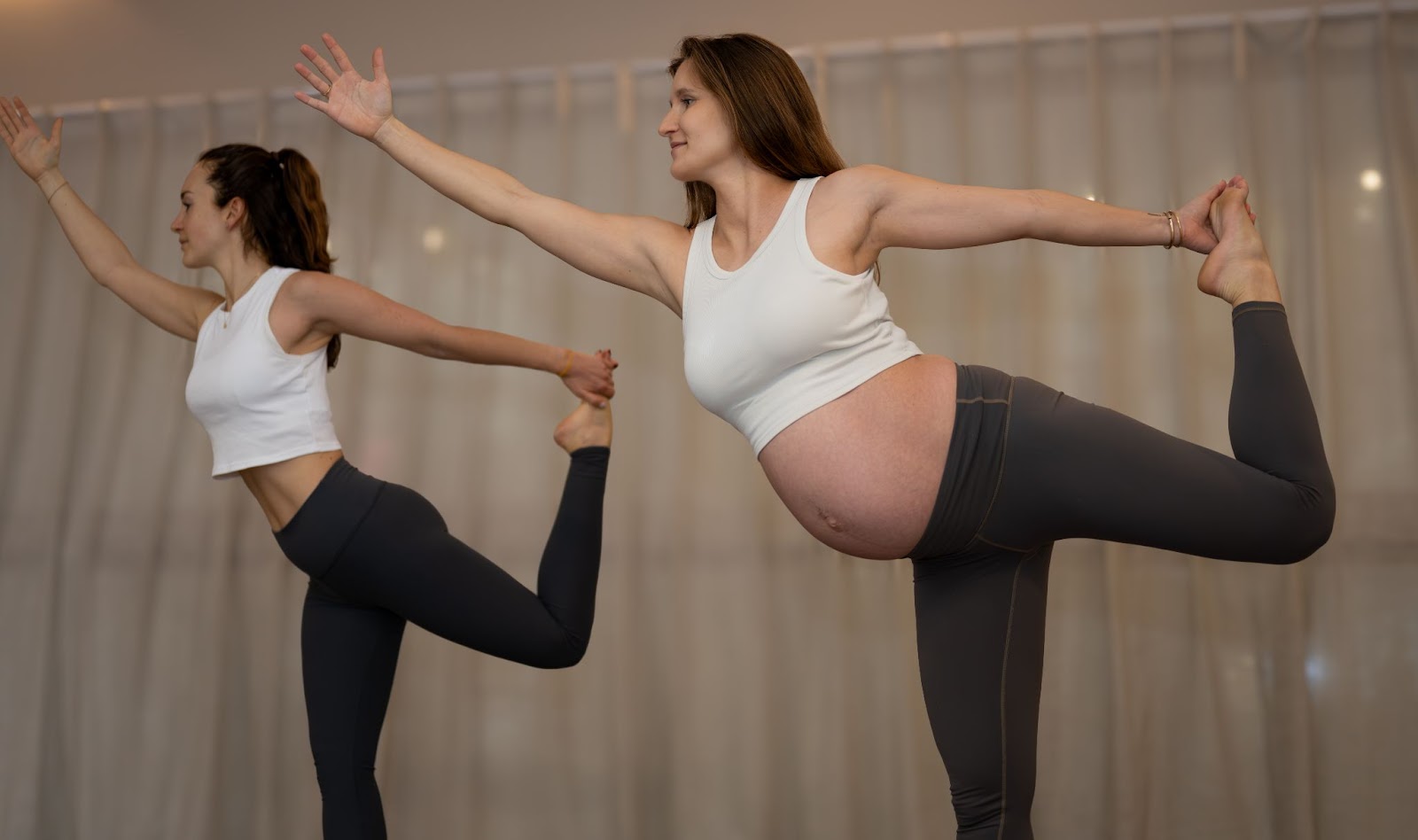
According to Rachel, yoga during pregnancy is much more than just physical movement. It’s about creating space – to breathe, to connect with yourself and your baby, and to prepare mentally and physically for pregnancy, childbirth, and beyond. Whether you’re a seasoned yogi or stepping onto the mat for the first time, prenatal yoga meets you where you are, helping you feel more in tune with your body’s changing needs.
So what exactly is Prenatal Yoga?
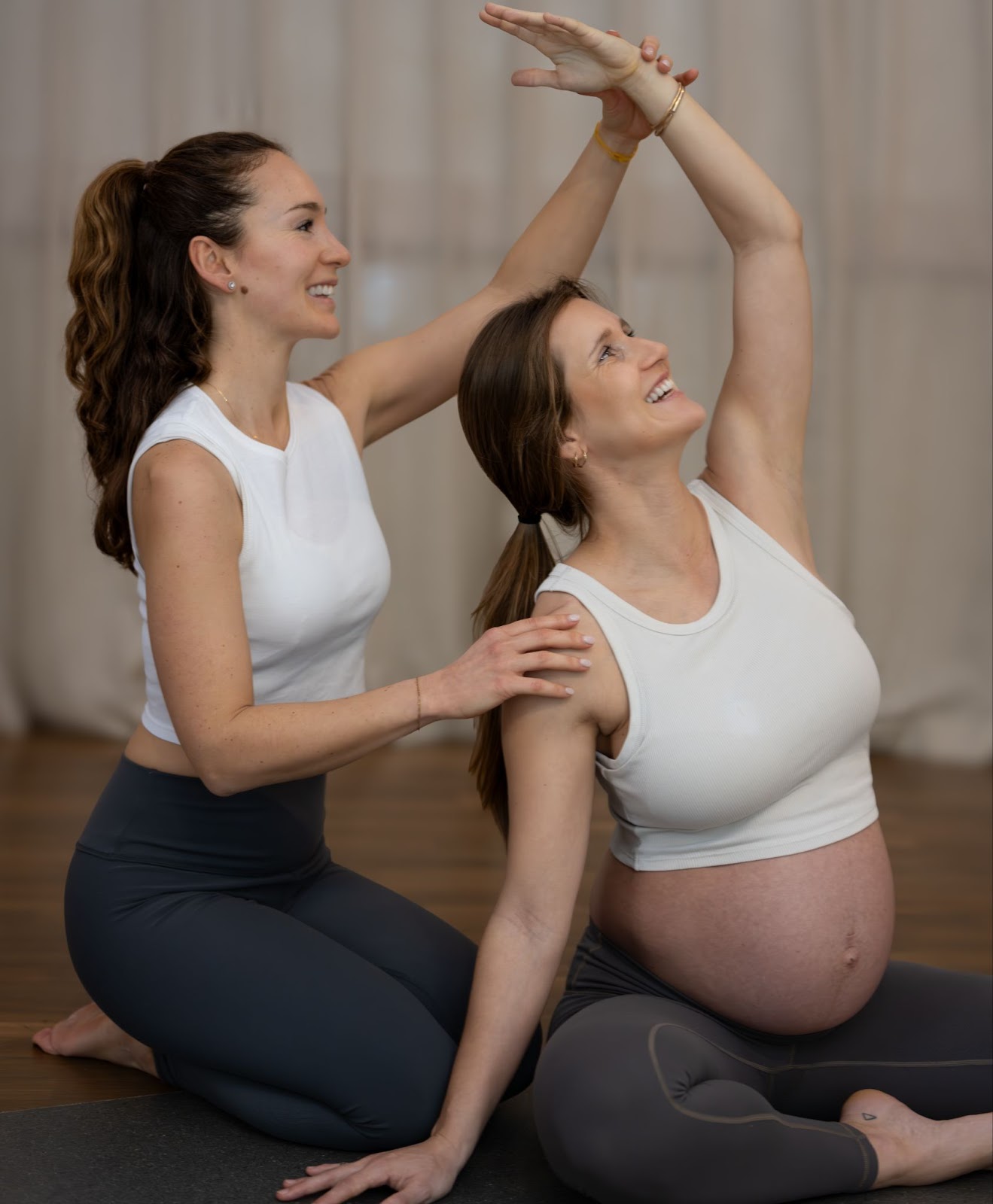
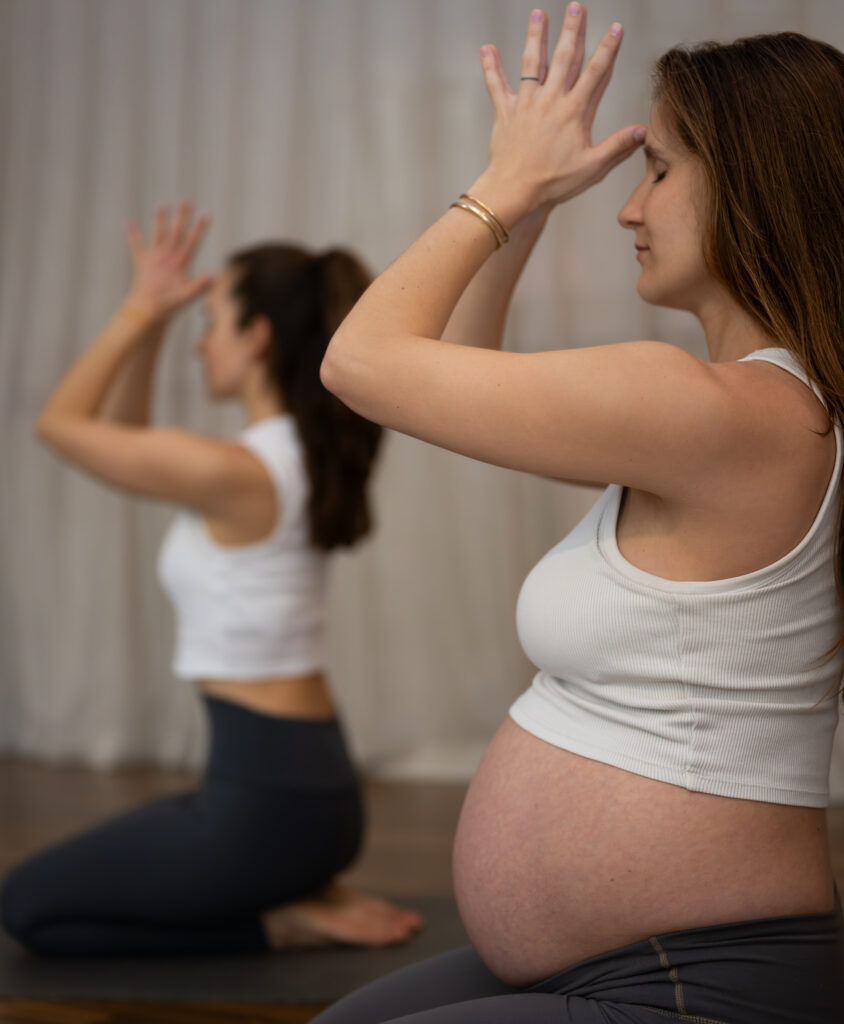
“Prenatal yoga is specially designed to support bodies as they change and prepare for childbirth”, Rachel explains. “By combining physical postures (Asana), breathing techniques (Pranayama), mantra, visualization and meditation, prenatal yoga offers a holistic approach to pregnancy health. Classes are tailored with an understanding of the different requirements of each trimester, offering options for a wide range of practitioners.”
Rachel advises against jumping into a vigorous Vinyasa class at 10 weeks pregnant if you’ve never practiced yoga before. The intensity and pace could be overwhelming, and certain poses might not be safe without specific modifications as your body changes. “The focus should be on gentle movements, breath awareness, and stability rather than pushing limits,” she says.
The Elements of Pregnancy Yoga

Physical Postures (Asana): Prenatal yoga postures focus on increasing flexibility, improving circulation, and relieving common pregnancy discomforts. These postures are gentle and adapted to the changing body.
Breathing Techniques (Pranayama): Breathing exercises in prenatal yoga focus on calm, mindful breathing to reduce stress, improve circulation, and oxygenate the body. These exercises can be used during labor and beyond into parenthood
Visualization and Meditation: These practices guide focus on breath and centering thoughts. This mindful approach fosters a sense of calm and mental clarity, which is essential during pregnancy, when hormonal fluctuations can often lead to emotional turbulence.
Mantra: Mantras are repeating words or phrases that bring focus, peace, and strength. In prenatal yoga, mantras can be used to build confidence, encourage relaxation, and invite positive energy.
Is Yoga Safe During Pregnancy?
Absolutely! Prenatal yoga, when practiced mindfully, is not just safe – it’s highly beneficial. Yoga provides a strong foundation to support and empower throughout every stage of pregnancy. It cultivates confidence and trust in what your body is capable of, infusing a positive mindset that carries through the transformative journey of birth and into the threshold of parenthood. Rachel emphasizes that pregnancy isn’t the time to push limits or master new poses. You’re already doing something extraordinary – growing a human! Yoga during pregnancy is about supporting that process, not challenging it. Here are some tips from Rachel to make sure, you practice it safely:
6 Safe Practice Tips for Prenatal Yoga
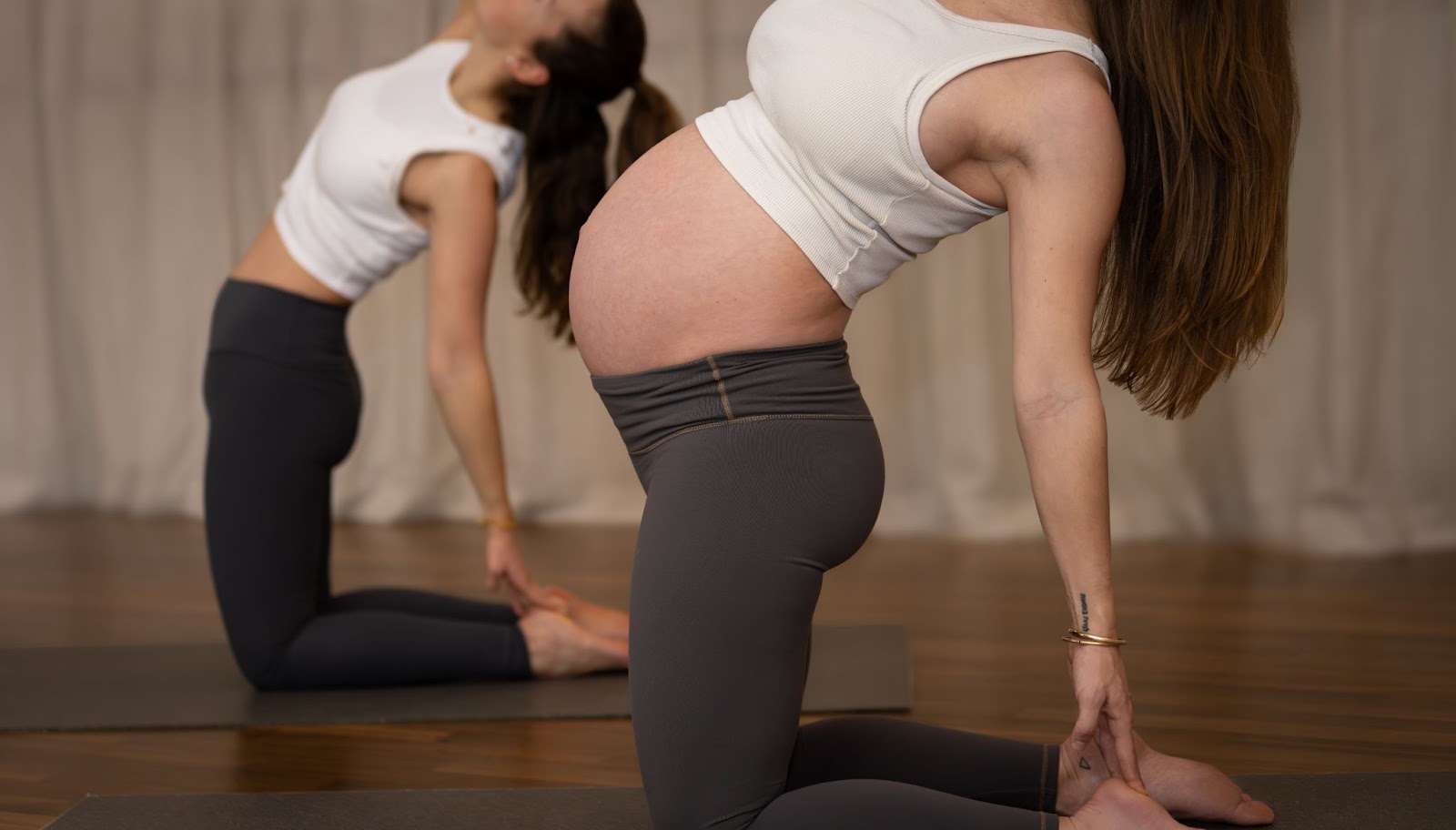
- Protect the Belly: Stick to gentle, open stretches and avoid deep twists, folds or lying on your belly that put excessive pressure on your abdomen. As that belly grows, it will start to kick back!
- Be Conscious of the Breath: Be mindful of keeping a steady breath. Avoid any types of breath holding or retention and intense breathing practices like Breath of Fire (Kapalabathi).
- Avoid New Challenges: If handstands or other advanced poses aren’t already part of your practice, now isn’t the time to start. Focus on maintaining your current practice safely.
- Stay Cool and Hydrated: Hormonal changes can affect temperature regulation. Drink plenty of water and practice in a well-ventilated space.
- Listen to Your Body: Every pregnancy (even in the same body) is unique. Pay attention to how you feel during each pose and avoid any movement that causes discomfort, pain, or dizziness.
- Consult Your Healthcare Provider: Always get medical clearance before practicing, especially if you have conditions like placenta previa, preterm labor, severe anemia, heart disease, or uncontrolled hypertension.
Poses to Avoid and Safe Modifications for Non-Prenatal Yoga Classes
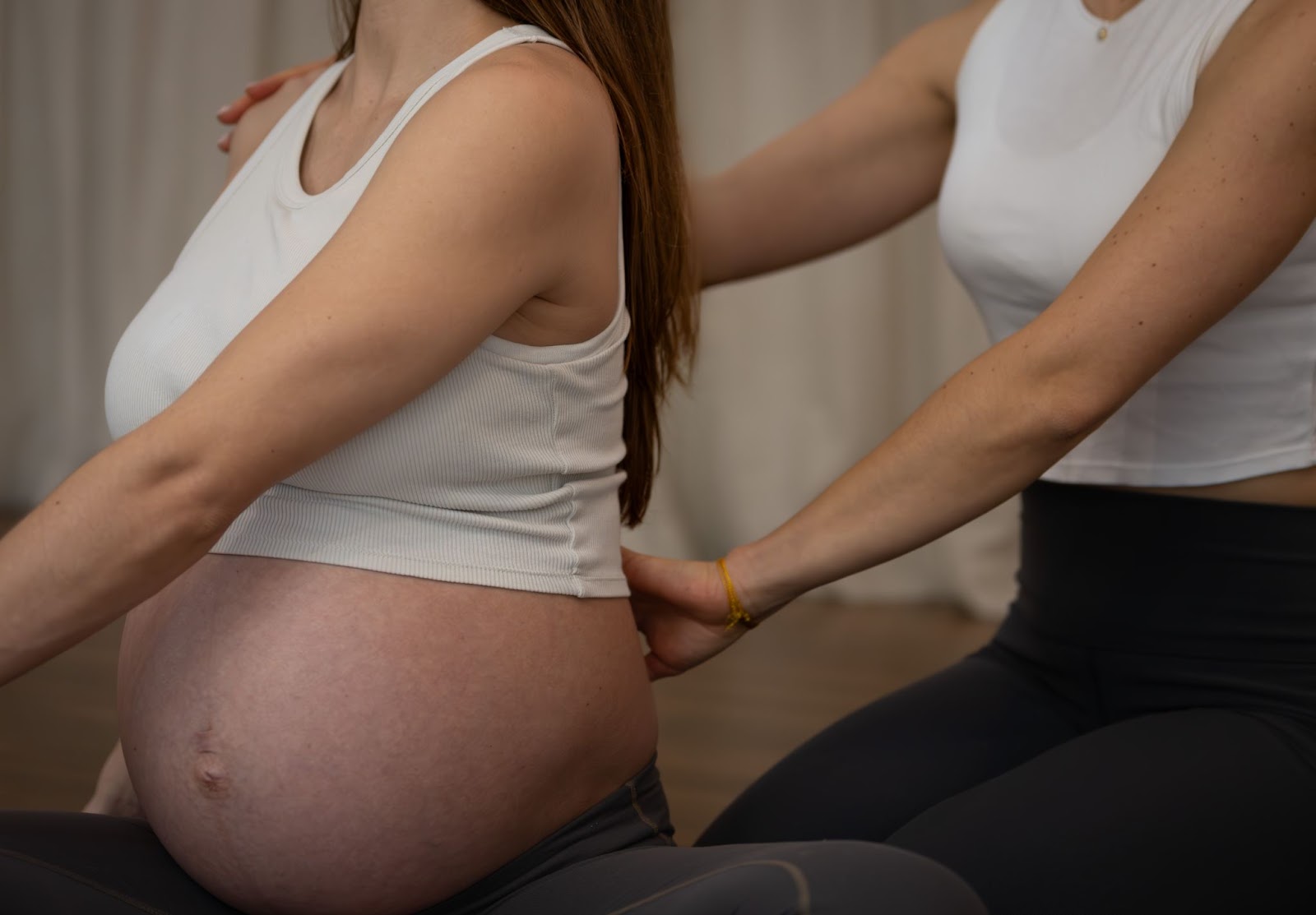
If you’re joining a general (non-prenatal) yoga class during pregnancy, making thoughtful modifications is key to ensuring both safety and comfort. Rachel advises being especially mindful of the following poses:
- Avoid Belly Compression: Steer clear of deep forward folds, intense twists, and any prone positions (lying on the belly) that put pressure on the abdomen.
- Limit Strong Core Engagement: Skip crunches and planks, and modify Boat Pose (Navasana) by keeping your feet on the floor.
- Be Cautious with Deep Backbends and Twists: Intense abdominal stretching or compression can strain the body – opt for gentle, supported variations.
- Avoid Lying Flat After the Fourth Month: Prolonged supine positions may compress the vena cava (a major vein), reducing circulation. Use props or side-lying alternatives instead.
- Minimize Rapid Transitions: Move slowly and with control – step back rather than jumping into Chaturanga Dandasana during vinyasa sequences.
- Prevent Overstretching: Pregnancy hormones loosen ligaments, so limit movement to 60-70% of your normal range, prioritizing stability over flexibility.
- Modify Balance Poses and Inversions: As your center of gravity shifts, practice near a wall, use props, or adjust poses for extra support and safety.
What are the Benefits of Prenatal Yoga?
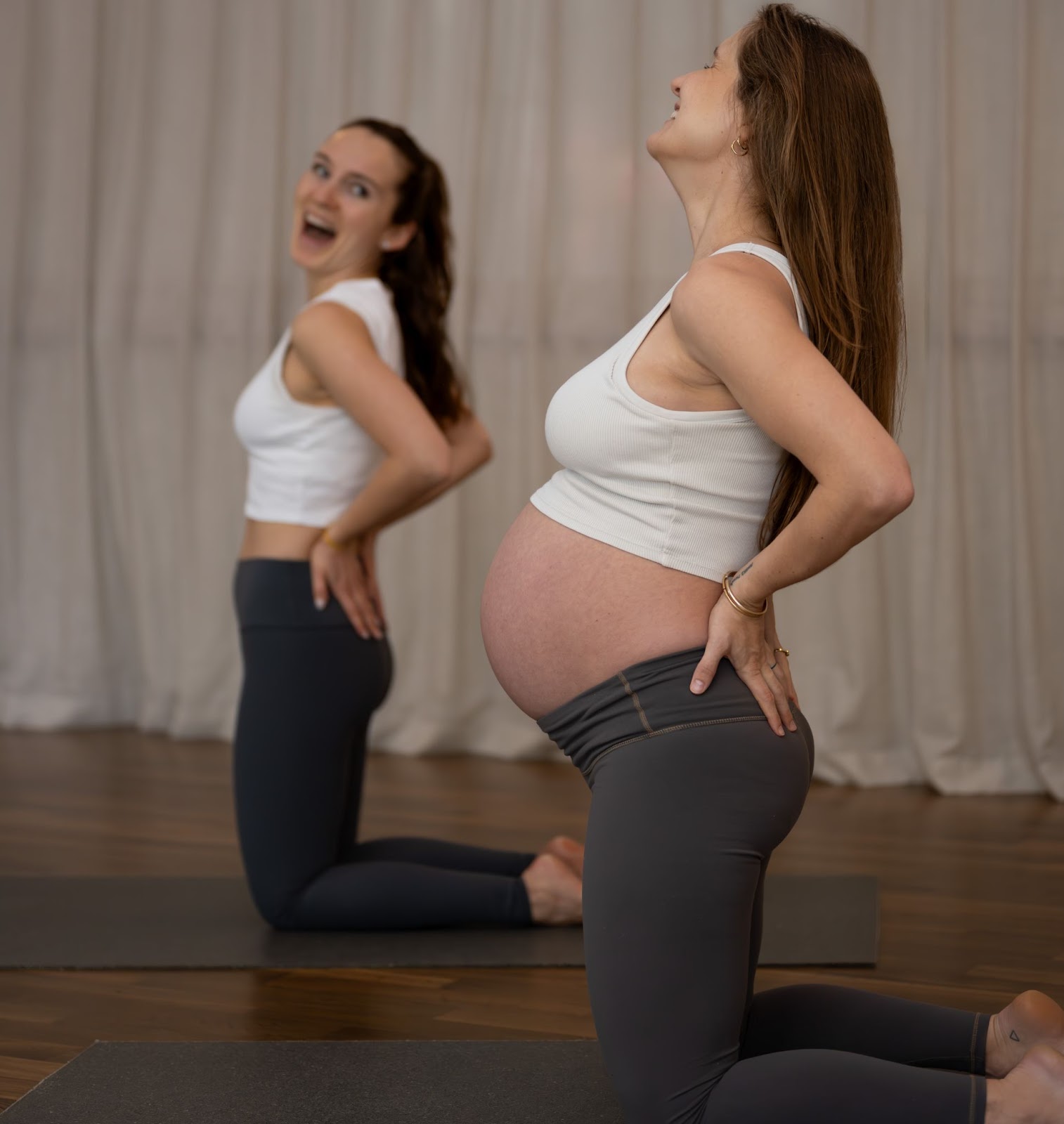
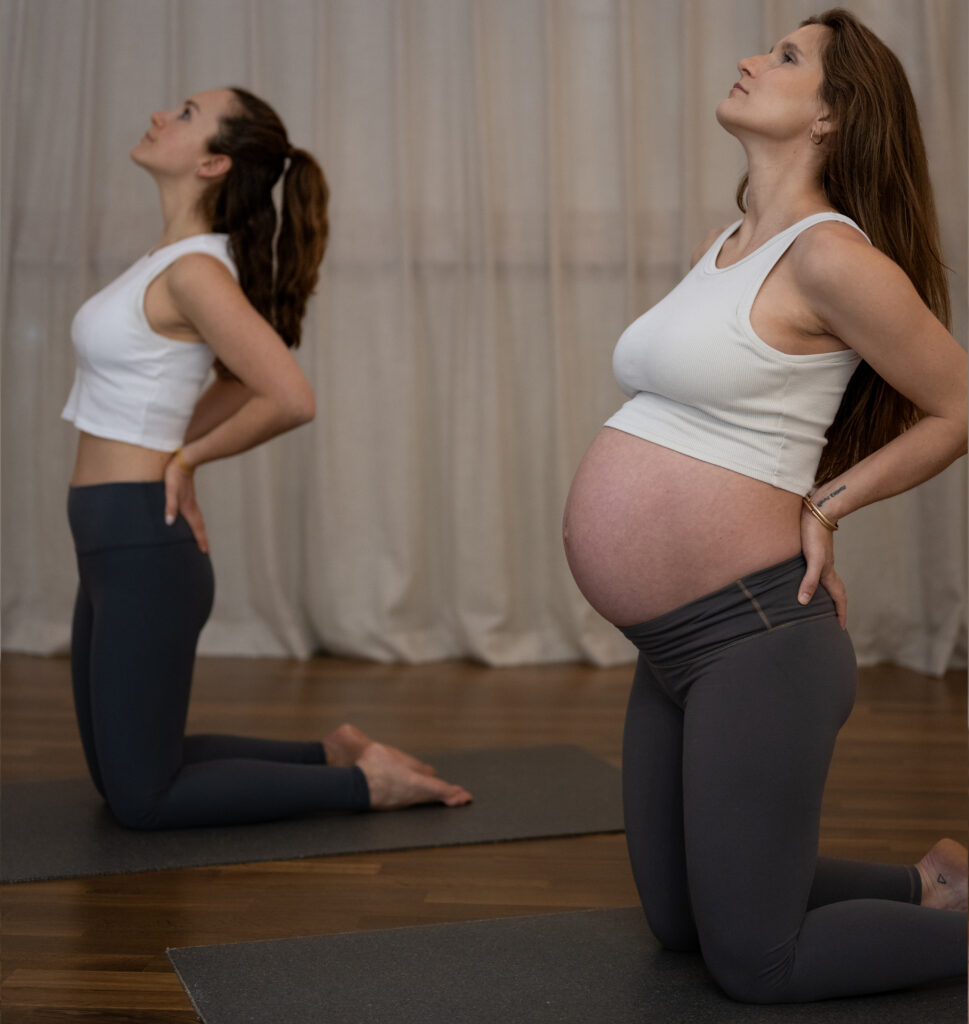
Physical Benefits of Prenatal Yoga
Prenatal yoga offers a range of benefits. Rachel highlights the four most impactful physical benefits you can experience:
1. Builds Strength and Stability
Prenatal yoga is all about moving slowly and mindfully, with an emphasis on smooth, even breathing. This approach helps you stay balanced and relaxed, reducing dizziness and nausea while promoting a sense of calm and grounding. During pregnancy, the focus shifts from extreme flexibility to building strength – especially in the hips, legs, and pelvic floor. This strength forms the foundation needed for childbirth and postpartum recovery.
2. Improves Your Posture
By incorporating props like yoga blocks, bolsters, and blankets, prenatal yoga helps you create the space you need. These props raise the ground, widen your stance, and provide extra room for your belly, allowing you to move more comfortably. Mindful alignment practices focus on chest opening and axial extension to counteract the forward pull from your growing belly. By paying close attention to each movement, you develop better posture awareness for your changing body. Visualizations and breath work further enhance the practice, supporting an open heart and an elongated spine.
3. Eases Common Discomforts
As your belly pulls forward, and your shoulders tend to round, prenatal yoga helps counteract poor posture and discomfort by strengthening the lower body, lengthening the spine, and opening the chest. Gentle, flowing sequences and mindful stretching ease common pregnancy discomforts such as lower back pain, sciatica, swollen ankles, and tight hips. Breath awareness enhances relaxation and releases tension.
4. Prepares Your Body for Childbirth
By enhancing pelvic floor awareness, breath control, and hip stability, you build the strength and stamina needed for labor and delivery. By linking movement with breath, you cultivate resilience, adaptability, and a deeper sense of trust in your body.
Mental and Emotional Benefits of Prenatal Yoga
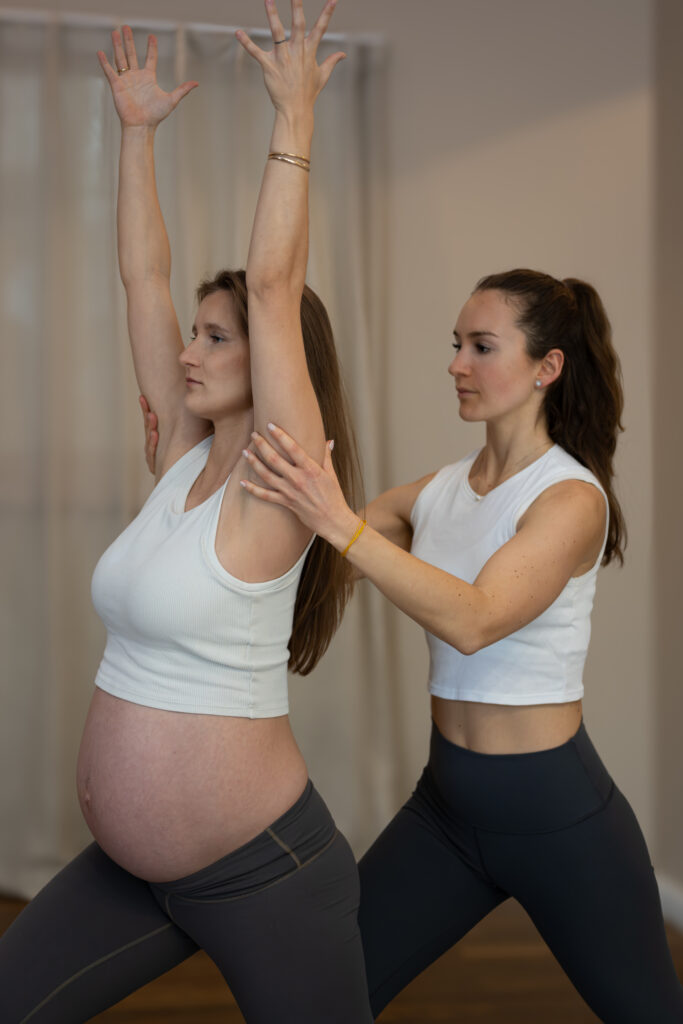
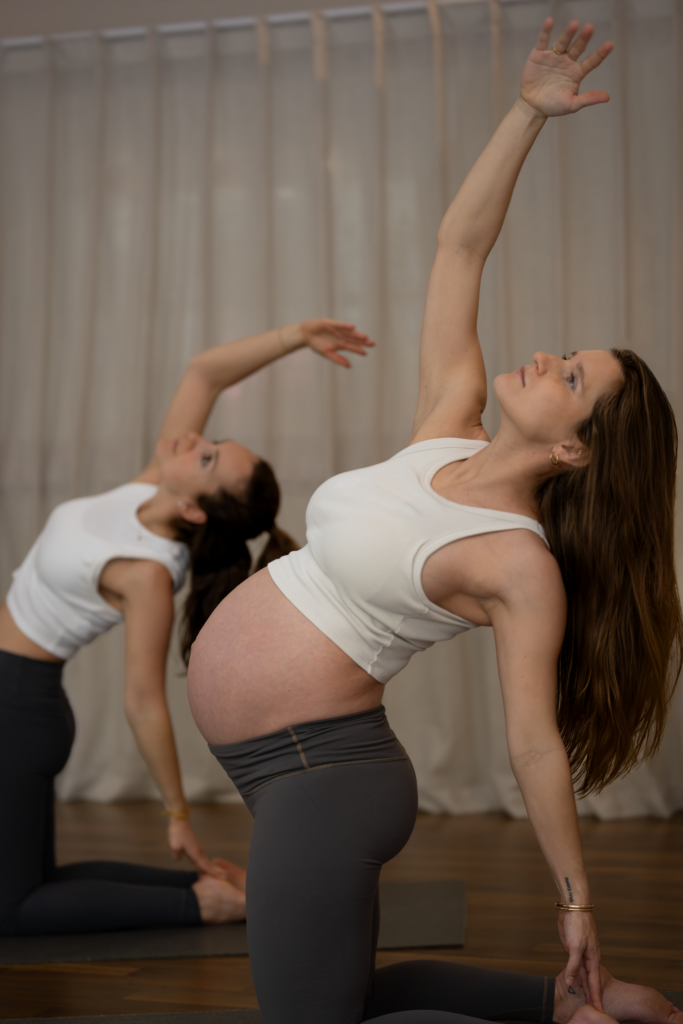
Rachel also dives into the four key mental and emotional benefits of prenatal yoga, explaining how it can help you manage stress, connect with your body, improve your mood, and build a sense of calm and confidence during pregnancy.
1. Reduces Stress and Anxiety
Prenatal yoga is a powerful tool for managing anxiety and boosting emotional wellbeing. With breath awareness (Pranayama) techniques, you can release tension and anxiety, fostering a sense of inner peace. Mindfulness practices encourage you to observe your thoughts and emotions without judgment, making it easier to navigate pregnancy’s emotional ups and downs with greater ease and resilience. This mindful awareness promotes emotional balance, reduces stress, and enhances your overall mental wellbeing.
2. Fosters Connection to Your Baby and Your Body
Mindful movement and meditation during prenatal yoga allow you to deeply connect with your baby and your changing body. By practicing gentle, intentional poses, you cultivate a heightened awareness of your body’s sensations, movements, and needs. This fosters a sense of appreciation and acceptance of your body’s transformation.
3. Promotes Mindfulness
The lessons learned on the mat and through the philosophy of yoga – like patience, awareness and self-compassion – can ease the ups and downs of pregnancy and early parenthood. Whether it’s getting out of bed, noticing your body’s reaction to a crying newborn, squatting and lifting correctly to pick up a child, or carving out a quiet moment for yourself – these small acts of mindfulness make a big difference. Applying yoga’s holistic approach to your day-to-day life transforms ordinary moments into opportunities for presence, balance, and deeper connection with yourself and your loved ones.
4. Builds Community and Provides Support
Prenatal yoga classes offer more than just physical benefits – they create a supportive community where you can share experiences, challenges, and joys with others on the same journey. They provide emotional support and camaraderie, helping to reduce the feelings of isolation that can sometimes accompany pregnancy. Practicing mindfulness together enhances a sense of belonging and empathy, reinforcing that you are not alone in your experiences.
Prenatal Yoga Through Each Trimester
Each trimester brings unique physical and emotional changes. Adapting your yoga practice to meet these needs can help support your body and mind through every stage. Always listen to your body and seek guidance from a qualified prenatal yoga instructor who understands the unique requirements of pregnancy.
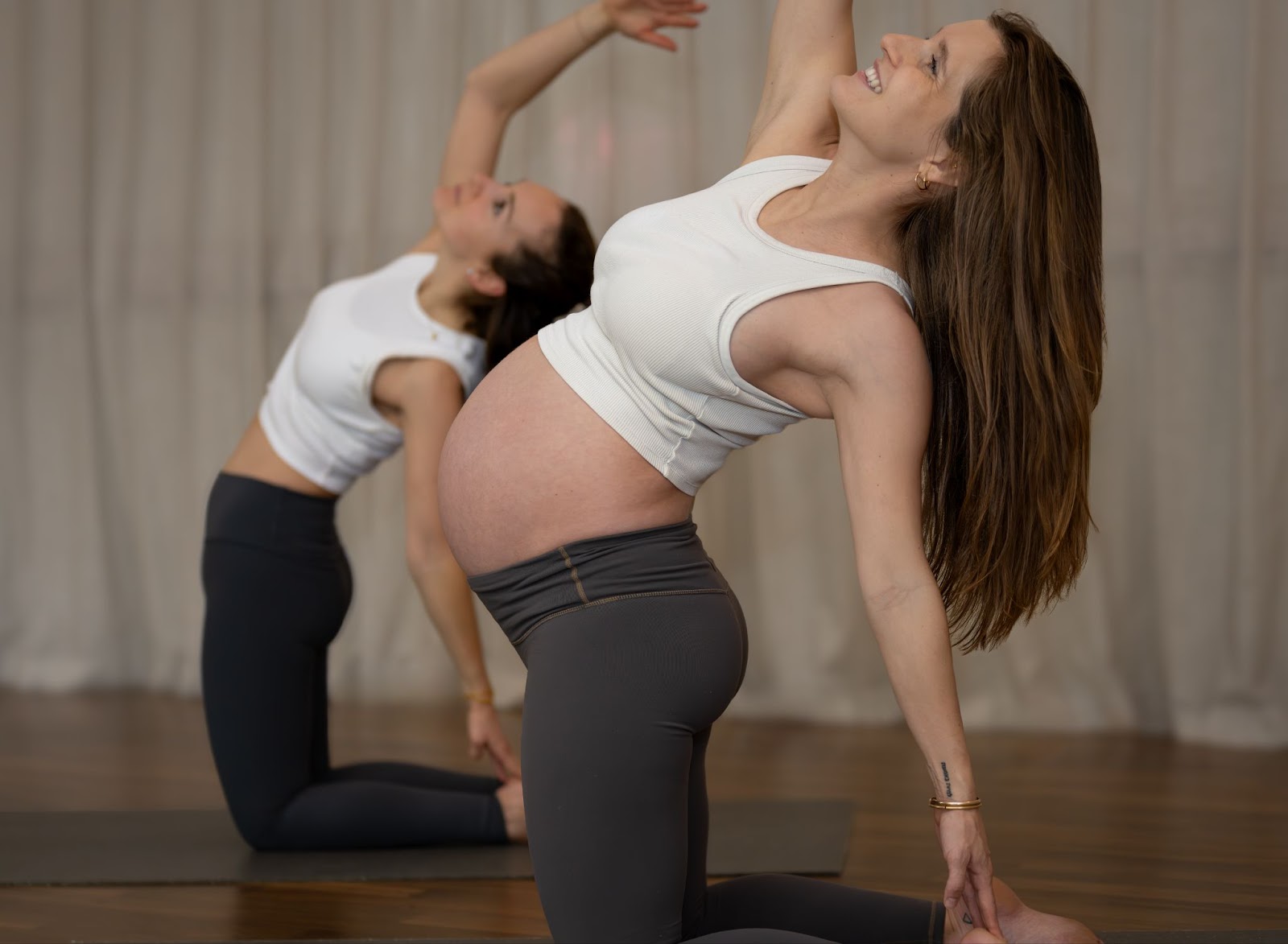
First Trimester (Weeks 1–12): Grounding and Nurturing
Hormonal shifts, fatigue, and nausea can make the first trimester challenging. Rachel recommends focusing on grounding poses and breath awareness to support emotional stability and ease physical discomfort.
- Body postures (Asana): Grounding poses like Mountain Pose (Tadasana), Garland pose (Malasana) and Child’s Pose (Balasana) promote stability and emotional balance.
- Gentle Stretching: Soft stretches, especially for the neck, shoulders, and lower back, can help alleviate early tension and fatigue.
- Breath Awareness: Practicing deep, mindful breathing helps calm the nervous system and promotes relaxation.
- Cautions: Listen to your body and rest as needed, especially if experiencing nausea, dizziness, or fatigue.
Second Trimester (Weeks 13–27): Building Strength and Stability
As the baby grows, the center of gravity shifts, affecting balance and posture. Rachel explains that this trimester is an ideal time to build strength and stability while maintaining a sense of calm and relaxation.
- Body postures (Asana): Warrior II (Virabhadrasana II), Goddess Pose (Utkata Konasana) and Tree Pose (Vrksasana) support the shifting center of gravity.
- Strength-Building: Focus on strengthening the legs, back, and pelvic floor muscles to support the growing belly and reduce back pain.
- Breath Focus: Incorporate diaphragmatic breathing (Belly Hugs) to engage deep core strength and practice awareness of the pelvic floor and diaphragm connection.
- Cautions: Avoid poses that require lying flat on the back for extended periods, as they can compress the vena cava (a major vein) and reduce blood flow. Use props like blocks and chairs for additional support and balance.
Third Trimester (Weeks 28–40): Relaxation and Preparation for Labor
In the third trimester, Rachel advises shifting the focus towards relaxation, gentle stretching, and preparing the body and mind for labor and delivery. This stage is about maintaining comfort and reducing anxiety.
- Body postures (Asana): Prioritize Cat-Cow Pose, Supported Child’s Pose, and Side-Lying Savasana that support blood circulation and relaxation.
- Pelvic Floor Focus: Incorporate pelvic floor lengthening and relaxation techniques to prepare for labor.
- Heart Opening and Expansion: Gentle heart-opening poses can improve posture and create more space for the lungs.
- Breathwork and Meditation: Pranayama (breath control) and guided meditations/visualizations/body scans help manage anxiety and promote better sleep.
- Cautions: Avoid any pose that compresses the belly or restricts breathing. Practice near a wall or use props for additional support and safety.
Where You Can Practice Prenatal Yoga

Are you looking for a supportive space in Berlin? Rachel teaches at VIVA Studio in Charlottenburg. Her classes are known for being welcoming and supportive, with a focus on mindful movement and community. During her maternity leave in Spring 2025, her colleague Stella – known for her calming presence and expertise – will guide the sessions. For more options, you can use your Urban Sports Club membership to access various prenatal yoga classes across Germany and Europe – giving you the flexibility to find a time and location that works for you.



Comments